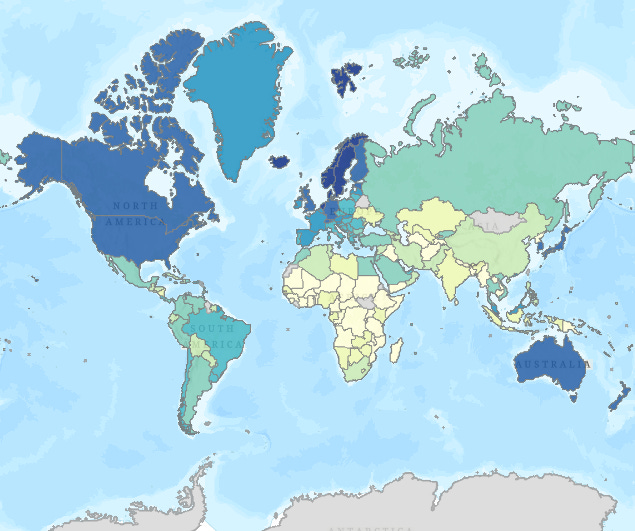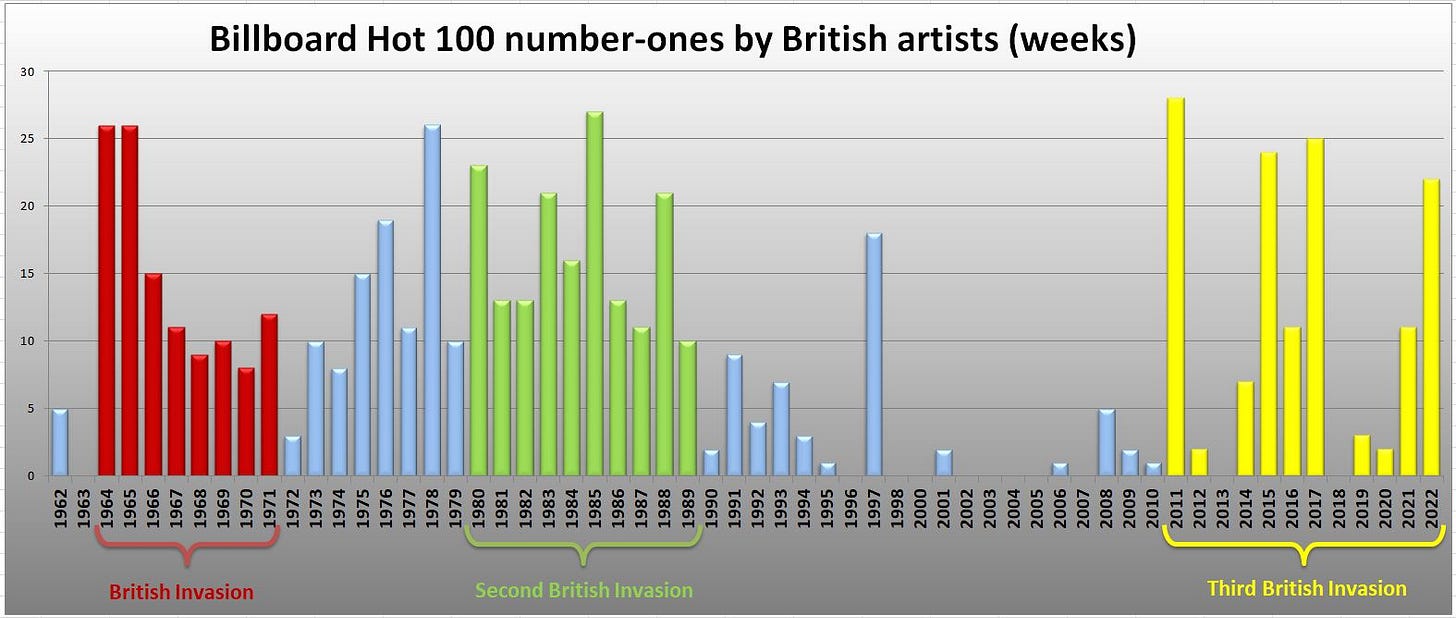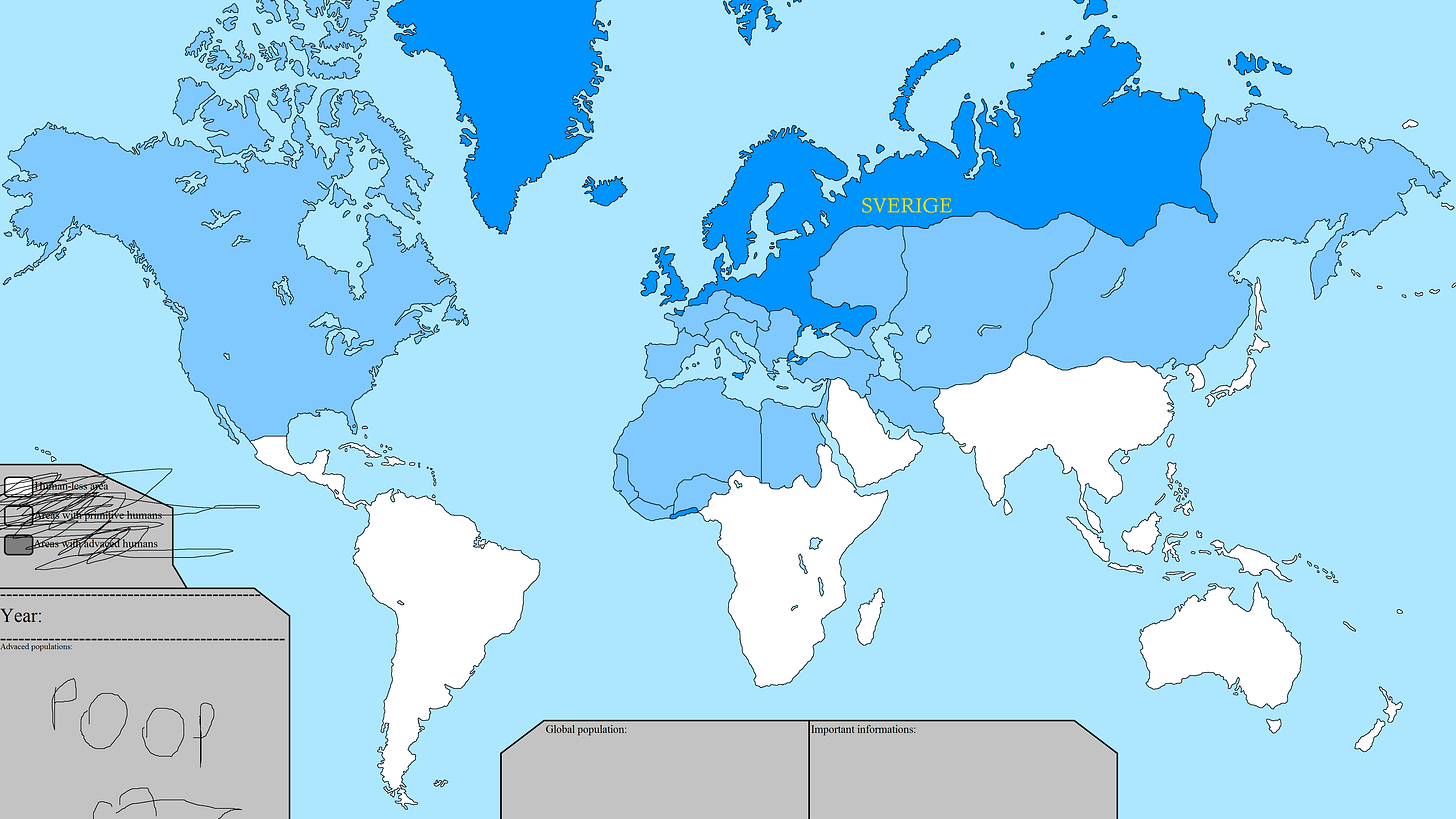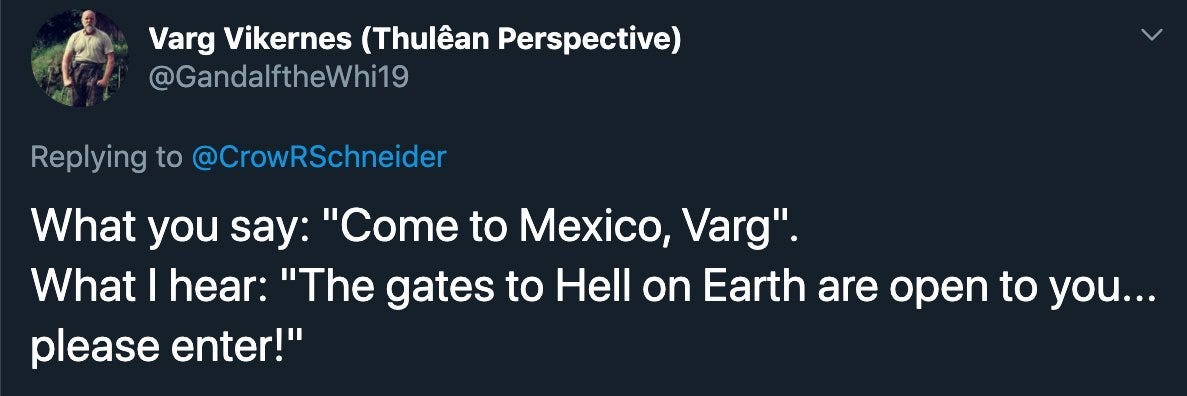Nations have a tendency of going through phases of fetishization of certain foreign cultures, for better or for worse. Historically, it was mostly limited to the aristocracy, because the lower classes lived very parochial lives and only rarely traveled. Sometimes, it is an ominous occasion for a people’s culture, linked with foreign domination or demographic shift. However, this is not necessarily the case. The French were very good at spreading soft power through culture, establishing themselves as an authority on cuisine, fashion, and art throughout Western Europe. The Italians were also able to accomplish this, but less so through the establishment of prestigious academies and moreso through the accommodation of pilgrims and gentlemen grand-tourers. The increase in pace of cultural shift and coverage of cultural trends has led to this phenomenon becoming much more noticeable within a single individual’s lifetime.
Most of these fads in America have been generated by internal cultures and immigrant cultures rather than external ones. For example, the Western craze of the mid 20th century, which itself seems to have led to a sort of Mexico Mania. Using Spanish slang became hip and cool. During our regency over the world, we have primarily played the role of culture exporter rather than culture importer, but there were some countries that broke into the American market.
We have gone through several phases of British mania, for example. It’s not surprising, considering that the United States was founded by Englishmen. British influence was strong in the 1960s and 1980s, especially in music. There were some other, non-musical elements of the British invasion though. Lawrence of Arabia and the James Bond movies won the hearts of Americans in the sixties, while in the eighties and early nineties Americans couldn’t get enough of Princess Diana. I feel like in the post-covid era, we have something more like a British dementia. Despite a lot of popular musical artists still being British, the idea of Britons as “trendy” or “hip” is totally laughable to Zoomers. The second most well-known foreign culture industry in America is the Japanese, which in my opinion reached its zenith in the nineties and early 2000s. The Japanese takeover of the American automotive market following the 1979 Oil Crisis, combined with an explosion in Japanese foreign investment during the 80s, caused many Americans to view the future as a Japanese one in the same way many people feel anxious about Chinese growth today. This belief seeped into the popular media of the time. Japan became the land of the future rather than a land of the past.
This was nothing compared to what was to come. Culture was becoming increasingly digital, and the Japanese had a head-start in the digital culture industry. They led the world in video games until the late nineties. Nintendo, Sony, Sega, Atari, and Capcom came sailing across the ocean like Yamato-class Battleships. The Japanese were also very good at selling other stuff to Children. They brought Gundam and Power Rangers to America, and the Japanese Takara Tomi worked jointly with America’s Hasbro in the creation of Transformers toys. Takara Tomi and Hasbro would again work together in creating the Beyblade toys. The toys fueled the media around them, not the other way around. It was the same with Pokemon. Yes, the games came first, but Pokemon made most of its money off of Merchandise and trading cards and still does today (or at least it did last time I checked). Yu-Gi-Yoh followed. Both franchises had a much greater impact on youth culture than Magic the Gathering or any other American trading card game. The influence of Pokemon was so great that it led to three or four separate moral panics among parents.
Japanese influence lingered on throughout the 2000s, and never fully went away, but the stagnation of the Japanese economy and the Japanese birth-rate conundrum ended fears about a Japanese future. The American auto industry recovered, Japanese investment in America declined, and Western companies got better at making video games and tech.
But there’s one period of foreign mania which I believe exists, but has mostly gone unnoticed. It lasted from around 2005 to 2015. The Nordic Mania. As in, the Fennoscandian world. Just as the Japanese had a head start in gaming, the Scandis had a headstart on the internet. Bluetooth was invented in 1998 by the Swedish company Ericsson. Skype was founded by Swede and a Dane, using Estonian programmers. All the way back in 1979, the Danish Bjarne Stroustrup developed C++. The Scandinavian world was the most online of any country in the mid-2000s.

Nordic overrepresentation on the early internet helped spread Nordic cultural influence, but so did the high English literacy of Scandinavians. The Dutch were also very overrepresented on the early internet, with one of their own being the inventor of Python, and they were also very fluent in English. Americans probably cannot tell the difference between the Netherlands and Scandinavia, so I would consider them partially involved in this pattern.
In 2008, Caramelldansen becomes one of the most iconic songs of early YouTube. The majority of people who heard it probably did not know that it was entirely Swedish and had nothing to do with Japan. In 2009, the alpha edition of a certain survival-adventure game from a Swedish indie company releases, and only a few years later it had become the most popular and successful video game in human history. In 2013, the Swedish YouTuber Pewdiepie becomes the most popular user on the platform. It is around this time as well that a Viking madness begins to penetrate American culture. Skyrim, Vikings (the TV show), and Thor (the movie) all get released in the early 2010s. It’s kind of hard to explain how much the modern perception of the Norsemen is a product of these three pieces of media, and I’m saying that as someone who has spent the past six years dodging the “worships marvel movies” accusations. Any time you meet someone in America who is “really into Vikings”, it is either the case that they like the faux-Vikings of the History Channel series, or it is the case that they emphatically deny being into the faux-Vikings and go on and on about historically accurate Vikings.
Scandinavia replaced Japan as the “future-past place”, where society was simultaneously very progressive and advanced, and also rustic and cultured. The “Scandinavian Model” became a sacred chant for the post-occupy American Left. Scandinavia was a magical utopia where everyone was sexy and tall, healthcare and college were free, bigotry did not exist, science was booming, children got good grades with less time in school, and the magical happiness statistic was higher than anywhere else on earth. They were an industrious, educated, and highly caffeinated people, but at the same time they had their own harmless cute traditions like believing in elves or eating strange food. I guess we should be thankful that Pickled herring didn’t become the new Sushi… Or should we? I have never tried Pickled Herring, I just assume it is not good. Tell me if I’m wrong.
The American Left used the “Scandinavian Model” that never was as a trojan horse for Democratic Socialism. The popular imagination of a Socialist changed from a Latin American dictator to a happy and free (and platinum blond) Norwegian, or perhaps even a Dutchman smoking weed while riding around the red light district on his bicycle. The influence of the “Nordic Ideal” on the right-wing was weaker and more limited to the online sphere, but it definitely existed. It was mainly something of the /fit/ space and the Manosphere. Scandinavians and adjacent groups like the Balts are outstanding powerlifters, and are very conventionally attractive. The “chad” of popular imagination was basically a Scandinavian male. Looksmaxxing has always been a fundamentally Nordicist movement, and the people who participate in it are the reverse Rachel Dolezals.
Around 2015, things began to change. Nordics were no longer very overrepresented online, as the internet had reached the normies across the Western world and was now spreading to the Global South. It was becoming very apparent that Sweden was not the paradise on earth people thought it was. The entire world was becoming aware of the Somalification of Stockholm. The once beautiful city was now associated with rapacious jihadists, no-go zones, and yakub-esque roadmen. “Swedemalia” began to get whispered around. Very progressive elements of Swedish society also became a target for ridicule by the Anti-SJW movement. Sweden was becoming a liability for the international left-wing, rather than an asset. The softness of Scandinavian society had resulted (apparently) in its ruin.
And then, in 2017, it happened. Pewdiepie, the most popular Scandinavian in the world, said the N-word live on stream. Later that year, the second most popular Scandinavian in the world (the one who created that little indie block-placing game I mentioned earlier) said “It’s OK to be White” on Twitter. A completely benign and reasonable thing to say, of course, but at the time it was called a Neo-Nazi dogwhistle. The wholesome chungus anti-bigoted Scandinavian of American imagination had been shattered. After the bridge incident there would be a grand investigation into the not so politically correct jokes that the YouTuber had made in his past, and his taste in a certain Japanese Fascist author. The entire internet was shaken up. People lost their careers over the succeeding demonetizations. During the Coronavirus Pandemic, the “Scandinavian Model” was no longer an economic program promoted by the American Left, but a more relaxed approach towards lockdown and social distancing promoted by the American Right. In Big 2025, the Nordic countries are some of the most anti-migrant and pro-remigration countries in Europe. The Swedish Win is real…
Here in America, we’ve moved on. I would say that the current big mania is Sino-Korean. And no, I don’t think that is too much of a stretch to lump Chinese and Korean together. The history of Korea since the 2nd century BC has been a process of Sinicization and adoption of Chinese mores. Yeah, Anime is more popular now than it used to be, but it’s drawn in Korean sweatshops. People eat “Korean Barbecue” to be trendy and watch “K-Pop”. Squid Games is one of the most popular TV shows and Parasite was named the best movie of the 21st century. Kids go on TikTok. Weaboos don’t play Persona anymore, they play Genshin Impact and Honkai Star-Rail (both Chinese) and Blue Archive (Korean). I can’t even get anyone to join my Pokemon Go raid battles because all of these pieces of shit are playing Chinese mobile games instead. Le sigh, I wish the Swedes won the Great Northern War. They were on a roll for a while, packing up Europe’s best teams despite being in the coldest part of Europe during a cold period. This is what earth would look like if they won the Great Northern War:
But alas, it wasn’t meant to be. Perhaps the true Finno-Korean Hyperwar happened beneath our noses 10 years ago. The Finns (Estonians included) lost, and this forced Soyciety to move on from the Nordic Mania to the Korean Mania. It was for the best, I think. Exporting kulcha to AmeriKwans has always ended up having a sort of osmosis effect. The media brought to America doesn’t exist in a vaccuum, it’s usually popular in the domestic sphere as well. Marketing to a mostly American audience forces the domestic culture industry to abide by shitty American norms, which subsequently Americanizes the domestic culture. This has never been an issue for American cultural exports, because there are just so many Americans. The only country which has been able to do it to some extent is China. The Chinese market is big enough that American sports leagues are willing to shut down good players for criticizing China, and American gaming companies are willing to ban or censor players who do the same. They can even get American movie producers to break their own wokeness and minimize the DEI of Amerikwan movie advertisements.
Maybe things will change when the reunited Kalmar Union conquers Siberia and unleashes methane trapped under the ice into the atmosphere, causing the Siberian Mammoth Steppe to become the most fertile land in the world. Until then, I think I’m just gonna sit here and play some Skyrim.
Thanks for reading











Don't forget the Frozen mania circa 2013/14. I would file that under Norse mania as well.
Varg has a tik tok now, also have u read mishima? It’s always funny to me how pewdiepie recommended the works of the “most right wing” person ever.